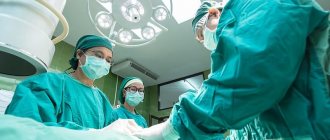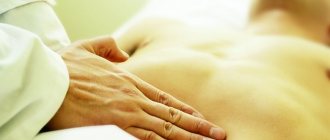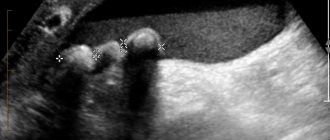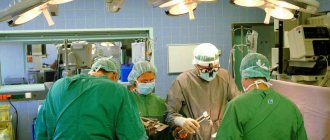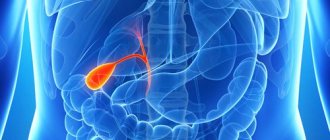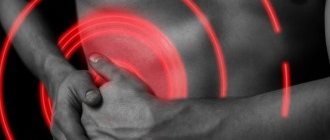General principles
The main goal of the diet is to ensure normal digestion of food and the secretion of bile.
To do this, doctors recommend that patients follow the following nutritional principles after surgery:
- You should eat 5-6 times during the day. Eating small portions reduces the load on the digestive organs.
- After removal of the gallbladder, bile is released in small quantities. Patients after cholecystectomy should reduce the amount of fatty foods in their diet.
- In daily nutrition, preference should be given to protein and vegetable foods, steamed. Recipes with fried foods are excluded.
Simple principles can reduce the risk of developing dyspeptic symptoms associated with insufficient bile secretion during digestion. This improves the quality of life of patients and prevents the occurrence of other diseases of the gastrointestinal tract.
General rules for eating without a gallbladder
The first month of nutrition after removal of the gallbladder differs from the standard features of a proper diet. Let's start with the fact that daily caloric intake is limited to 1600-1900 kcal, depending on the individual characteristics of the body. It is necessary to reduce the load on the digestive organs, so patients should eat pureed food, excluding fatty foods, smoked foods, high-calorie foods, etc. The priority is various porridges, lean steamed meat, and fermented milk products.
After the specified period, the patient is transferred to a basic diet: in the absence of a gallbladder, treatment table No. 5 . Simple carbohydrates must be excluded. This is due to the fact that this category of products contributes to the stagnation of bile. These include all kinds of sweets, including honey and jam. chips. crackers, fast food, etc. Citrus fruits and sorrel are strictly contraindicated.
Salt is practically unlimited, the maximum limit is up to 8 grams per day. Drinking regimen - up to 2 liters per day.
It is important! Often after removal of the gallbladder, concomitant diseases of the gastrointestinal tract occur: gastritis. gastroduodenitis, pancreatitis, etc. If these pathologies are present, the diet is adjusted by the attending physician.
What happens if you don't follow a diet?
Diet after cholecystectomy is a necessary part of rehabilitation. The amount of bile secreted in operated patients decreases, which affects the digestion process. Failure to comply with these principles increases the risk of developing diseases of the esophagus, stomach, pancreas and small intestine.
Patients with poor nutrition may develop esophagitis, cholangitis, gastritis, colitis and other inflammatory diseases. Their occurrence is associated with impaired digestion of food products and the creation of favorable conditions for the proliferation of pathogenic microorganisms.
Food in a medical facility
After the operation, the patient remains in the hospital for 3 to 10 days. The length of hospitalization depends on the type of intervention performed and the presence of complications. The “gold standard” for gallbladder removal is laparoscopic surgery. Patients are discharged after it after 2-3 days. It is performed through small incisions on the anterior abdominal wall and differs from open cholecystectomy in its rapid recovery.
In the first 6 hours after waking up from anesthesia, the patient should not get out of bed, drink water or eat. You can have a snack only the next morning. Preference is given to liquid products: oatmeal, dietary vegetable soups and kefir. Gradually increase fluid intake - from small sips of water to normal drinking throughout the day.
It is necessary to exclude from the diet all fatty, fried, smoked and spicy foods, as well as confectionery and chocolate.
Drinking strong tea, coffee, carbonated drinks and alcohol is prohibited. These foods can cause indigestion. Gradually, fermented milk products, water-based porridge, mashed potatoes, and lean meats are introduced into the diet day by day. Patients are recommended to eat baked apples, pears, and bananas after removal of the gallbladder, starting 5-6 days after surgery.
Your doctor and nutritionist will help you choose the right diet. They evaluate not only the operation performed, but also concomitant diseases and lifestyle features.
Why is diet necessary?
Removing the gallbladder does not stop the body's production of bile. The liver continues to function, bile is secreted in the same volume as before. And the risk of its accumulation in the ducts increases, which can harm the intestines. To prevent such a situation, it is important to follow a strict diet. Fractional meals are of great importance - this will allow the bile to exit on time, protecting the intestines from significant influxes, and also preventing the formation of stones in the ducts.
After some time, the function of the missing gallbladder will fall on the ducts. This becomes possible by following a diet for a long time. On average, about a year passes before returning to a normal diet from the moment of surgery.
Doctors recommend following diet No. 5. And there are certain rules regarding nutrition for the first days after surgery, weeks, months, etc. At all these stages, the diet and recommendations will be different.
Meals during the first week at home
After the patient is discharged from the hospital, doctors recommend following certain nutritional recommendations during the first week. Food should be taken in 6-7 doses, which reduces the load on the gastrointestinal tract. The last meal is 2-4 hours before bedtime. Taking a large amount of liquid (2-2.5 liters) improves the functioning of the digestive system.
For the first week, patients adhere to dietary table No. 1. It is based on excluding rye bread, fresh vegetables and berries from the diet. These products stimulate bile secretion, which is contraindicated in the early rehabilitation period. It is recommended to eat steamed meat, vegetable or fish dishes. It is important that the food is warm, not hot or cold.
When planning a sample menu, doctors advise including the following products:
- steamed chicken fillet rolls;
- milk-based soup with the addition of any cereal;
- soufflé made from lean meat, such as chicken or rabbit;
- egg white omelette;
- kefir or low-fat yogurt;
- Adyghe cheese.
The specified diet becomes the main one in the first week after discharge. In the future it gradually expands.
Meals in the first month
The diet during the first month is aimed at normalizing and adapting the gastrointestinal tract and generally improving a person’s well-being. In addition to changing their diet, patients begin to attend physical therapy classes and carry out other prescriptions from the attending physician. An integrated approach to the rehabilitation period is necessary to prevent the development of secondary diseases of the gastrointestinal tract.
The products should not include smoked meats, spicy, fatty or fried foods and alcoholic drinks. Tobacco smoking is also excluded. The diet is based on dietary table 5a. It reduces the chemical and mechanical effects of food on the gastrointestinal tract, which improves their functioning. Preference is given to boiled fish and meat, steamed meat dishes, egg white omelettes, vegetable soups and fermented milk products. You can eat porridge cooked in water, stewed vegetables and fruit jelly.
First year after cholecystectomy
Dietary table 5a is indicated for patients for 12 months after surgery. In this case, you should regularly consult with a gastroenterologist about the state of the digestive system and the need for nutritional correction. After a year of dieting, a subsequent expansion of the food intake is possible. However, general nutritional recommendations remain similar:
- fractional meals - 4-5 meals, two of which are snacks;
- the serving size is small, since the amount of bile released during digestion is limited;
- During the day you need to drink 2-2.5 liters of liquid: water, natural juice, etc.;
- Fried foods are not allowed. Preference should be given to steaming, stewing and boiling;
- reduce the consumption of confectionery products, coffee and strong tea.
In the first three months after surgery, a person should be under constant medical supervision. The doctor evaluates the presence of pathologies in the digestive system and, if necessary, adjusts the diet. This approach allows for the prevention of diseases of the gastrointestinal tract.
Dietary changes are an important part of rehabilitation after cholecystectomy. As a result of the operation, the gastrointestinal tract is not able to secrete a sufficient amount of bile to digest fatty foods, which imposes certain restrictions on the patient’s diet.
During the first year after surgery, the diet gradually expands. However, all fatty, spicy or smoked foods, as well as alcoholic drinks, are prohibited.
In what cases is the gallbladder removed?
Cholecystectomy is a surgical operation to remove the gallbladder. The entire organ is removed through surgery. Without it, people lead their usual lifestyle, following nutritional rules.
When functioning normally, the gallbladder plays an important role in the digestion of food. In the case of pathological processes occurring in the organ, it causes a lot of inconvenience: it worsens well-being and health. Symptoms appear:
- Stomach ache;
- Stool disorder;
- Nausea and vomiting;
- Increased body temperature, etc.
- Gallstone disease (GSD). It occurs with severe symptoms in the form of acute pain in the stomach, high fever, and profuse vomiting.
- Acute cholecystitis. A person experiences a feeling of nausea, vomiting, increased body temperature, cramps in the abdomen, and bitterness in the mouth.
- Choledocholithiasis is a type of cholelithiasis.
- Formation of polyps on the gallbladder.
With these diagnoses, the patient requires surgical medical intervention. Modern medicine, when removing an organ, performs cholecystectomy using laparoscopy. The duration of the operation is from 30 minutes to 1.5 hours. The surgical method allows you to perform an operation that reduces the time for rehabilitation after removal of the gallbladder and helps to avoid postoperative consequences.
Reviews
Dear readers, your opinion is very important to us - therefore, we will be happy to provide feedback on fruits and vegetables after gallbladder removal in the comments, this will also be useful to other users of the site.
Faith:
After removing the gallbladder, the doctor said that I could eat fruit and drink coffee. Well, I somehow had my doubts about coffee, but he didn’t say what fruits I could eat. I started eating apples initially. I felt discomfort, and the nurse suggested that I need to bake them first. So she diversified her meager diet at least a little.
Galina:
It was a terrible procedure and I had a long recovery. I don’t know about others, but I’m tired. You can't eat anything. The first days you are generally hungry, you can’t even drink. I wet my lips and it was all to no avail. A month later it got better, but it wasn’t particularly pleasant either. But there was no other way out.
Postoperative period
After the organ is removed, the patient is immediately transferred to the intensive care unit and given proper care. The patient should remain in the hospital until he recovers. Complications are possible with cholecystectomy. Today, the operation is performed laparoscopically, complications and undesirable consequences are minimized. For the first time (12-24 hours), you should not get out of bed, eat or drink. If you need to stand, you need to move with the assistance of medical personnel. After anesthesia, dizziness and fainting are possible. The recovery period lasts 7 days. After 10 days, if the patient’s condition is satisfactory, the patient is discharged.
A person whose gallbladder has been removed should follow the following advice:
- Do not violate the dietary table, follow the diet. Healthy food, a balanced diet menu is an important part in the process of restoring the body. The diet after laparoscopic cholecystectomy must be followed for life. The purpose of dietary nutrition is to stimulate the removal of bile from the body and stabilize metabolism. If the patient does not adhere to the doctor’s nutritional recommendations, attacks of cholecystitis are possible.
- Use of medications. Drug therapy helps a person adapt to living without a gallbladder. The patient is prescribed hepatoprotectors - a class of drugs that perform a protective function for the liver. Six months later, the body recovers after laparoscopic cholecystectomy.
- Doing exercises. Massage exercises for the abdomen (two months). At first, you should do the exercises under the supervision of a doctor. It is recommended to limit physical activity for a month.
Three important rules will help the body adapt to life after surgery, quickly improve well-being and normalize the functioning of the gastrointestinal tract. Failure to comply with your doctor's instructions will negatively affect your health.
General principles of diet after laparoscopy
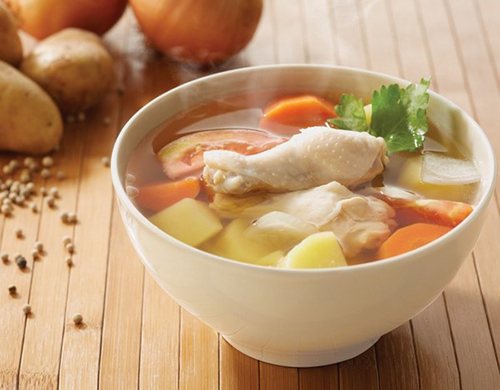
The diet after laparoscopic cholecystectomy is called “table No. 5”. It has varieties, marked with additional capital letters, for example, Ш, А. The basis is the same. This is a set of products that have the most gentle effect on the organs of the digestive system.
According to the fifth table, foods are steamed, boiled or baked. Frequent consumption of food in small portions is provided. Accordingly, the use of bile flowing non-stop from the liver into the esophagus is being found. Later, the function of its accumulation will be partially taken over by the ducts.
The therapeutic diet excludes chewing large pieces. Grinded products should be consumed. These are digested faster and more easily absorbed by the body.
The basic rules of the diet after removal of the gallbladder by laparoscopic method include:
- Eating food should occur at the same time. Such nutrition will help regulate the functioning of the digestive organs. Bile will begin to be secreted more actively during the usual meal times. Thus, the absence of a bubble is compensated by a kind of drill of the body, developing the habit of working more actively at certain hours.
- The ratio of proteins, fats, carbohydrates and the daily amount of calories is set by the attending physician depending on the constitutional characteristics, metabolism and body mass index of the patient. As a rule, it is recommended to consume no more than 2 thousand kilocalories per day.
- The amount of salt consumed is limited to 6 grams per day.
- Food should not be cold or hot. A spasm of the sphincter that allows bile to pass into the intestines may occur.
- It is forbidden to eat too heavy food before bed, which causes stress on the digestive organs.
- It is important to drink at least 2 liters of fluid per day in order to reduce the concentration of bile. Its stagnation leads to inflammation, intoxication of the body, and re-formation of stones, but not in the bladder, but in the ducts.
After cholecystectomy, it is necessary to give up bad habits such as alcohol abuse and smoking. Increased load on the liver leads to complications after surgery.
The daily diet after laparoscopy is less strict compared to nutrition after a traditional operation. The new technique is low-traumatic, so the rehabilitation period is shorter, and the list of approved products is wider.
Diet after surgery
Nutrition after cholecystectomy is aimed at restoring metabolic processes in the body; food should be healthy and gentle on the stomach. Before preparing for surgery, it is important for a person to adjust to changes in the usual diet and restrictions in the first month.
After laparoscopic cholecystectomy, diet number five is recommended.
Diet recommendations after gallbladder removal:
- The first days are the hardest. You can’t drink water or move around on your own. You are allowed to take a sip of water and rinse your mouth with neutral herbal decoctions. After 1 day, you can drink liquid (up to 1000 ml per day). As you feel better, under the supervision of your doctor, drink unsweetened compote (from dried fruits), weakly brewed tea (preferably with the addition of medicinal herbs), and low-fat kefir.
- After cholecystectomy they begin to eat after 3 days. You need to keep a diet. In the first 5 days of the postoperative period, mashed potatoes, butter (1 teaspoon), unleavened broths, fish dishes (in a water bath), carrot juice, jelly (from fruits, berries) are gradually added to the menu. Portions should be 150-200 grams. Eat 6 times a day at exactly the right time.
- On day 5, you are allowed to diversify your diet with fermented milk products, dietary cottage cheese, crackers, bread crumbs, vegetable puree, and pureed porridge with water. The first postoperative week is the most difficult.
- For 1.5 months after laparoscopic cholecystectomy, meals should be fractional, small portions, and sparing foods. Dishes are prepared in a steam bath and boiled. Limit the addition of salt and sugar. Avoid spicy seasonings. Follow the doctor’s recommendations, monitor your health, the period of recovery depends on this. A conscientious attitude will bring positive results and in a month you will return to your normal lifestyle.
Table of food products (allowed and prohibited) after cholecystectomy
Despite the restrictions, the food of a person with a removed gallbladder remains balanced. The body needs constant replenishment of nutrients and beneficial microelements. Proper nutrition is the key to quick recovery. After the operation, there is a lack of appetite. It is important to tell your doctor about this.
In order to competently approach the rehabilitation period and adaptation of the stomach after cholecystectomy, it is important to know which foods are allowed to be consumed and which are strictly prohibited.
The menu is allowed to include:
- Dietary poultry meat;
- Slaves for a couple;
- Rabbit meat;
- Fermented milk product with low fat content;
- Goat milk;
- Eggs (white omelette);
- Butter;
- Buckwheat, rice, pearl barley, oatmeal;
- Fruits (with the exception of citruses and sour fruits);
- Vegetable stew;
- Melon, watermelon (are good diuretics);
- Berries (strawberries, blueberries, cherries, cherries);
- Still mineral water (prescribed for therapeutic purposes, course 30 days, take a break after a month);
- Vegetarian soups;
- Juices from vegetables and fruits (unsweetened);
- Dried fruits (dried apricots, prunes, raisins);
- Kissel;
- Marshmallows, marshmallows, jelly, honey, jam.
Fresh fruits and vegetables are prohibited. They provoke increased secretion of bile.
It is recommended to add new foods gradually, while monitoring how you feel after eating. If abdominal discomfort occurs, temporarily exclude the dish from your diet.
Prohibited Products
List of products that can disrupt the gastrointestinal tract - cause abdominal cramps and create excessive stress on the digestive process:
- Foods high in vegetable oil;
- Spicy, spicy, fatty foods;
- Marinades, canned food (if it contains acetic acid);
- Smoked meats;
- Garlic;
- Radish, radish;
- Salo;
- Bakery and confectionery products;
- Beans, peas (legume products contain coarse fiber);
- Mushrooms;
- Carbonated juices, mineral water;
- Nuts;
- Seeds;
- Sauerkraut;
- Cold dishes, ice cream, ice;
- Strong tea, coffee;
- Cocoa-containing products (chocolate, candies, desserts, confectionery);
- Alcohol (wine, champagne, vodka).
If you exclude the listed foods, you can avoid unpleasant consequences and complications. After a year, you can introduce some foods from the list of prohibited foods into your diet; a diet is used, scheduled by day. Nutrition is discussed with the attending physician.
Acceptable diet after laparoscopy gallbladder removal for patients
The patient will certainly benefit from a diet after removal of the gallbladder; laparoscopy in this case helps to carry out the operation quickly and painlessly. It should be remembered that the intervention of a surgeon very often leads to significant disruption in the functioning of the human body. That is why, having decided to undergo surgery, the patient must be prepared for quite serious changes in diet. A properly selected diet after removal of the gallbladder is almost always aimed at gradually normalizing the metabolic process and stimulating the removal of bile that is unnecessary for the body.
What is allowed to eat after surgery?
Dietary nutrition after laparoscopy of the gallbladder requires strict restrictions. Doctors may allow a patient to drink only 1 day after surgery. It is best to use medicinal decoctions or mineral water. Before this, after surgery, the patient can wipe his lips with a cotton swab soaked in water several times an hour, and then rinse his mouth with decoctions that were prepared based on medicinal herbs.
To avoid pain after laparoscopy, after 2 days after surgery, the patient’s diet should be slightly varied with unsweetened jelly or unsweetened tea. The most acceptable diet after removal of the gallbladder involves the use of kefir, which has low fat content. The patient can drink approximately 1.5 liters of liquid per day.
On the 3rd day after laparoscopy of the gallbladder, it is allowed to slightly expand the dietary intake.
A patient can improve their health faster by consuming the following foods:
- fruit jellies, soups,
- cooked in weak broth;
- boiled fish, apple,
- pumpkin and beet juices;
- egg white omelet, mashed potatoes.
You are allowed to drink a small amount of sweet tea. Complications may appear on the fifth day after surgery. However, in order to avoid this problem, you need to adhere to a diet. The menu selected by a specialist contains crackers, white bread, and cookies. The following products are allowed to be included in the diet:
- fermented milk products, oatmeal, wheat and buckwheat porridge;
- cottage cheese, boiled meat, vegetable puree, boiled fish.
Recommended Diet
If cholecystectomy has been performed, the patient must strictly follow a diet. During this you should eat 6 times a day. All dishes must be prepared in the most gentle ways. You can boil foods in water or use a double boiler.
Subsequent rehabilitation after removal of the gallbladder by laparoscopy involves eating the most healthy foods. For example, doctors recommend the following products:
- curd puddings, boiled fish and meat, fruit jelly;
- zucchini and fresh carrots, scrambled eggs, mashed potatoes or vegetables;
- juices, milk porridges, meatballs and meatballs;
- vegetarian soups, steamed cutlets.
When 1.5 months have passed after the operation, the diet includes vegetarian cabbage soup, 1 egg per week, boiled sausage, crumbly porridge, and milk. It is prohibited to consume canned food, hard-to-melt fats, alcoholic beverages, cakes, smoked foods, spicy seasonings, sausages, and pickles.
Proper nutrition includes rabbit meat, vegetables, vinaigrettes, fruits, beef and veal, and cereals. After removal of the gallbladder, the postoperative period may drag on for several months. To ensure that it passes without problems, boiled potatoes, tea, vegetable salads, and cheese sandwiches are introduced into the patient’s diet.
Berries and fruits should be used as the most acceptable and healthy dessert for breakfast. Lunch may consist of vegetarian borscht, soup with meatballs, boiled meat dishes, stewed cabbage, carrot or beet juice.
Only a doctor can tell the patient what kind of physical activity is beneficial for him and what foods should be consumed. For example, at night you are allowed to drink fresh juice, which must be diluted with water. Many clinics perform a procedure such as laparoscopy of the gallbladder, the postoperative period of which can be completed without pain.
After surgery, it is necessary to choose the freshest food products that have undergone thorough heat treatment. It is necessary to adhere to all the recommendations of doctors who, in addition to a healthy diet, advise the use of therapeutic exercises. Therefore, a hernia after laparoscopy will not appear in a patient who has recently undergone surgery.
mypechen.ru
Sample dietary menu after laparoscopic cholecystectomy
There are many options for a balanced diet after surgery. Knowing how to properly prepare permitted foods, you can make your meals healthy, tasty, and varied. Create a menu for the week. Use different cooking methods. A strict diet will help cope with gastrointestinal pathologies, excess weight, and improve health. Remember! Portions should be small (200 g), meals should be fractional (6 times a day), the volume of water drunk should not be more than 2 liters. After 3 months, almost all vegetables and fruits are added to the menu.
Let's look at the diet after laparoscopic cholecystectomy and examples.
- Breakfast. For your morning meal, prepare oatmeal. You can add a piece of butter to porridge or rye bread. It is recommended to drink green tea (you can make decoctions from medicinal plants).
- Lunch. Grated apples without peel.
- Dinner. Chicken soup with vegetables (carrots, potatoes, broccoli, chicken fillet, parsley, a little salt). Bread with cheese (hard cheese, low-fat), compote from a mixture of dried fruits.
- Afternoon snack. Kissel with crackers, bananas.
- Dinner. Prepare minced fish cutlets in a steam bath. Cottage cheese casserole, compote.
- Second dinner. At night you can drink a glass of yogurt.
- Breakfast. Prepare a white omelette (separate the yolk). Make a rosehip decoction.
- Lunch. Apricots are suitable for a snack.
- Dinner. Dietary vegetable soup (cauliflower, carrots, bell pepper, salt). For the second course, prepare cod liver. Oatmeal cookies for dessert, warmed milk.
- Afternoon snack. Yesterday's bread (crackers), cheese, compote.
- Dinner. Cooking pasta with gravy. Tea with milk. For dessert, dates, raisins or marshmallows.
- Second dinner. A portion of low-fat cottage cheese.
- Breakfast. Millet porridge, juice.
- Lunch. Diet yogurt.
- Dinner. Soup (champignons, potatoes, greens). Unsweetened cookies, compote.
- Afternoon snack. Steamed zucchini, mint tea.
- Dinner. Boil shrimp and make mashed potatoes. For dessert, fruit jelly and tea.
- Second dinner. A glass of fermented baked milk and crackers.
- Breakfast. Buckwheat porridge, herbal tea and souffle (you can add raspberries, the berry activates the digestion process).
- Lunch. Dairy products (kefir, yogurt).
- Dinner. Cook the fish in a steam bath and make a salad. Drink a glass of juice.
- Afternoon snack. Boiled corn, compote.
- Dinner. It is allowed to prepare pizza using approved products for filling. As a dessert, tea with marshmallow.
- Second dinner. Light salads are suitable.
- Breakfast. Diet cottage cheese (can be ground in a blender, add a little dried apricots), green tea.
- Lunch. Banana.
- Dinner. Mashed potatoes with fish cutlets. Marshmallow, tea.
- Afternoon snack. Sandwich, rosehip infusion.
- Dinner. Seafood soup. Tea with jelly.
- Second dinner. Dried apricots, raisins.
It is not recommended to use tomato juice at first. You are supposed to eat strictly following the doctor’s instructions and recommendations. The duration of treatment and eating behavior are prescribed individually. To ensure that the recovery period passes quickly and without complications, lead a healthy lifestyle.
Diet for the first days of cholecystectomy on the bladder
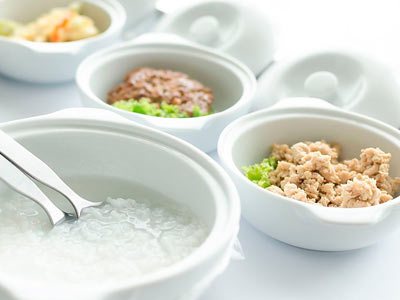
- There is no need to eat anything on the day you are scheduled for surgery.
- The first day after surgery: weakly brewed tea, juice diluted in a 1:1 ratio with water from sweet fruits, compote based on dried fruits (a glass 5 times a day).
- Second day after surgery: a portion of porridge made from rice or semolina, pureed oatmeal, jelly from berries or fruits, soups based on cereals (mucous).
- The third or fourth day after surgery: lean meats or fish (boiled or steamed), a serving of low-fat cottage cheese, white crackers.
Sample menu for 4 days after cholecystectomy on the bladder:
| Breakfast | A portion of oatmeal porridge with milk, a glass of weakly brewed tea. |
| Snack | A glass of dried fruit compote, some crackers. |
| Dinner | Slimy soup based on rice cereal, meat soufflé, a glass of weakly brewed tea |
| Snack. | A glass of rosehip decoction, some crackers. |
| Dinner | Steamed fish fillet, a glass of weakly brewed tea |
For two or three weeks from the fifth day after surgery, you must adhere to a gentle version of diet No. 5. This diet involves chopping all food into small pieces that are convenient to eat.
The meal table includes:
- Boiled vegetables, baked apples.
- Bread made from wheat grains.
Sample menu for a gentle diet No. 5.
| Breakfast | A portion of oatmeal porridge, boiled fish fillet, a glass of tea |
| Snack | A serving of low-fat cottage cheese, a glass of rosehip decoction |
| Dinner | Vegetarian vegetable soup with barley, steamed meat cutlets, carrot puree, fruit-based jelly |
| Snack. | Baked apples. |
| Dinner | Steamed omelette, a portion of rice porridge with milk, a glass of tea. |
Diet for 2-3 weeks after laparoscopy on the bladder.
After a few weeks, it is recommended to follow diet No. 5 or No. 5a. The goal of diets No. 5 and 5a is to prevent disease of the biliary tract by reducing the impact on them, the intestines and stomach.
Eating regimen: 5 times a day.
In the first days and weeks, drink about 1.5 liters of water per day. Dinner should be three hours before you go to bed.
In the first days and weeks, it is prohibited to include animal and artificial fats, spinach, sorrel, garlic, onions, fresh vegetables and fruits, and coffee in the food table. You should not eat sweets: cake, pastries, chocolates. It is recommended to limit salt intake: no more than 10 g per day. Do not eat salty, spicy and smoked foods, as well as foods with a lot of sugar.
The previous menu includes:
- All vegetable soups.
- Steamed cutlets or soufflé from fish and meat.
- Light varieties of cheeses.
- Vegetable casseroles.
- Fruit based mousse.
- Sweets: pastille, jam, marmalade.
Diet for 2 months after laparoscopy on the bladder
The goal of the diet after 2 months from gallbladder removal is to avoid injuring the digestive system and dilute the bile by taking more protein dishes and foods.
Eating regimen: 5 times a day. It is recommended to drink about two liters of water per day.
If you feel normal and do not have digestive diseases, then after 2 months you will be able to gradually include fresh vegetables and fruits in your diet and table. If something is wrong and you have any illnesses, then do not forget to consult with your doctor.
Features of nutrition after cholecystectomy
Bile is known to be produced by liver cells. From the liver it moves along the hepatic ducts. Part of the bile from the common hepatic duct enters the gallbladder. The remaining part moves further along the common bile duct and from there enters the duodenum.
Bile is produced by hepatocytes almost constantly. But this liquid, in fact, is needed only during the digestion process. But our body is so intelligently designed that the produced “excess” bile accumulates in the gallbladder. And when a person starts a meal, bile flows out of the bladder and reaches the intestines, where it takes part in the digestion process .
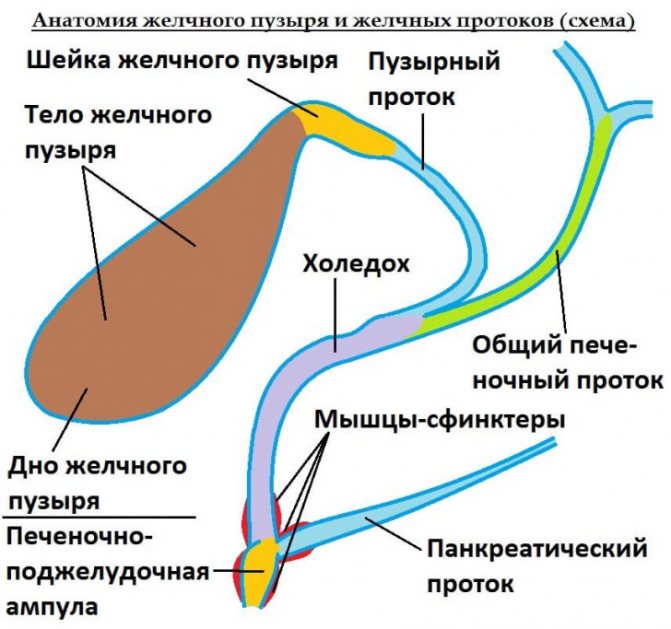
In case of some diseases of the gallbladder, cholecystectomy is sometimes not possible to avoid. In this case, bile is still produced in the liver, but it simply goes down the bile ducts and does not accumulate anywhere, because there is no longer a reservoir . Bile is produced constantly, but in small portions. Therefore, with a large meal, this amount of bile will not be enough to ensure complete digestion of food. Actually, this aspect is taken into account when drawing up a therapeutic diet.
Diet after cholecystectomy involves a gradual expansion of the diet. So, on the first day after surgery, the patient is prescribed fasting, on the 2-4th day - therapeutic diet No. 0a, on the 5-7th day - surgical diet No. 1. From the second week of the postoperative period and for 1.5-2 months, the patient should adhere to diet No. 5 . And only a few months after the operation you can try to switch to the general diet table No. 15, while of course you need to follow the dietary habits when the gallbladder has been removed.

Diet in the first days after gallbladder removal
The first day after surgery involves absolute hunger . The patient should not even drink, only wet his lips with water if he is very thirsty. On the second to fourth day, the doctor prescribes dietary table No. 0a to the patient. This means that the patient can already drink water. And in general, the diet is represented mainly by liquid and semi-liquid dishes. Allowed dishes under dietary table No. 0a:
- Still water;
- Rose hip decoction;
- Kissel from sweet berries, dried fruits;
- Black, green tea (most importantly not strong);
- Kefir 1 percent;
- Diluted natural juice (apples, pumpkin, beets);
- Fruit jelly.
Note! The main condition of the diet after cholecystectomy is fractional and, importantly, regular meals. You need to eat six times a day, the interval between meals should be three hours. Such rules were invented for a reason, because frequent meals prevent the stagnation of bile. The volume of food serving per meal is 150-200 ml. The food should be warm. Eating cold food can lead to dyspeptic disorders and abdominal pain.
After cholecystectomy, the patient should try to eat at the same time every day. The same postulate should be adhered to in the future, let it become a habit. Eating food on a schedule will improve the process of bile synthesis and its storage in the bile ducts.
This will have a better effect on the digestion process.
Nutrition on the fifth to seventh day after cholecystectomy
On the fifth to seventh day after surgery, doctors recommend that the patient switch to dietary table No. 1. In addition to previously used dishes, the diet includes dried bread, crackers and biscuits of the “Maria” type, liquid pureed cereal porridges, pureed vegetables, soufflés from lean meat and fish, unsweetened cottage cheese and other dairy products, strained soups, cooked in water (you can add a little butter), protein omelet.
Sample menu for the day:
- 8.00 - liquid pureed oatmeal, steam omelet, tea;
- 11.00 - 0% cottage cheese, rosehip decoction;
- 14.00 - slimy soup with semolina, chicken soufflé, compote;
- 17.00 - beef puree, rosehip broth;
- 20.00 - white fish soufflé, as well as thin rice porridge;
- 22.00 - rosehip decoction.
It is important to drink about one and a half to two liters of liquid per day, including still water.
Video
|
|
Nutrition from the eighth day after surgery
If the patient has already passed a week of the postoperative period, then it is time to switch to therapeutic diet No. 5. Doctors recommend sticking to this diet for at least 1.5-2 months . Food is prepared by boiling or steaming. You need to eat six times a day and try to stick to a daily eating schedule. In this case, you need to drink about one and a half liters of liquid per day.
Allowed dishes for therapeutic diet No. 5:
- Lean meat and fish in the form of soft soufflé, boiled pieces, steamed cutlets, meatballs;
- Steam omelet (be sure to remove the egg yolk before cooking);
- Vegetable, cereal, and milk light soups;
- Cereal, well-mashed porridges, which can be cooked exclusively with water or milk;
- Vegetable purees (including potatoes);
- Steamed cottage cheese casseroles;
- Diluted fruit jelly, juices;
- Vegetable stew;
- Baked apples;
- Dried bread, crackers, Maria-type biscuits;
- Durum pasta.
Diet No. 5 is characterized by a reduced fat content (with the absolute exclusion of refractory fats) and limited carbohydrate content. At the same time, the amount of protein in food remains normal.
Sample daily menu for diet No. 5:
- 8.00 - steam omelette, buckwheat porridge, tea;
- 11.00 - 5% cottage cheese, rosehip decoction;
- 14.00 - oatmeal soup with permitted vegetables, mashed boiled beef soufflé;
- 17.00 - baked apple;
- 20.00 - boiled white fish in pieces, pumpkin puree;
- 22.00 - berry jelly.
The duration of stay on diet No. 5 is determined by the doctor, taking into account the tolerability of such therapeutic nutrition and health status . Doctors recommend that some patients eat according to dietary table No. 5 for 1.5-2 months, and other patients - for a whole year. After this, if there are no contraindications, you can gradually expand the menu. But at the same time, it is necessary to adhere to the basic nutritional principles of dietary table No. 5, and also avoid prohibited foods.
After switching to a common table, a person can already eat low-fat cabbage soup, pickles and beetroot soups, non-rich broths prepared with chicken, steamed meatballs and cutlets . There are many recipes for interesting dishes made from permitted products. All you have to do is put in a little effort and your diet will become varied and tasty!
What fruits can you eat after cholecystectomy?
The absence of a gallbladder is not an obstacle to eating the fruits and berries that many people love . But it is worth noting that some fruits are still prohibited. These are, first of all, fruits and berries of sour varieties, as well as those that enhance fermentation in the intestines (grapes). But even after removal of the gallbladder, you can still continue to enjoy fruits such as:
- Apples (baked only);
- Pear;
- Apricots, peaches;
- Bananas;
- Sweet cherry;
- Ripe raspberries;
- Sweet varieties of strawberries;
- Watermelon.
In the first weeks after cholecystectomy, the above fruits and berries can be safely consumed in the form of jellies, jelly and compotes. Baked apples are especially well tolerated during this period. After about a month, these fruits can be eaten raw without cooking.
Danger: new stones
The absence of a gallbladder does not guarantee that a person will never have gallstones again. Their formation is caused either by changes in the composition of bile, or by its stagnation (with dyskinesia of the gallbladder). Alas, the operation does not change the composition of bile. And stagnation can occur again, only now in the bile ducts.
How to avoid?
Eat little and often. Each meal stimulates the secretion of bile, and the more often this happens, the less likely stagnation is. The ideal option is 5-7 times a day. But if a person sits down at the table only 2-3 times a day and his meals are plentiful, bile retention is very likely.
Reduce your cholesterol intake. It is from this that stones are formed. Eat less fatty meat, butter (about 20 g per day), choose low-fat dairy products.
Move. 1.5–2 months after the operation, it is advisable to start walking – 30–40 minutes daily. Walking prevents bile stagnation. Swimming works in a similar way: the water provides a gentle massage to the abdominal cavity. You can sign up for the pool six months to a year after your gallbladder is removed. Morning exercise is also useful - you can start it at the same time as walking. But you can strain your abdominal muscles no earlier than after a year.
Prohibited products
After removal of the gallbladder, the body has to adapt to changed conditions, and accordingly, the digestion process also undergoes changes. These nuances must be taken into account; some foods worsen the digestion process and can cause dyspepsia and abdominal pain. After cholecystectomy you should avoid the following foods:
- Fried foods;
- Fatty meats, poultry and fish;
- Smoked products, canned food;
- Meat broths;
- Refractory fats (these are fats of animal origin, including lard);
- Spices, herbs (restriction of salt in food is recommended);
- Pickles;
- Ice cream and any other cold foods (cause severe abdominal pain due to spasm of the sphincter of Oddi);
- Carbonated and alcoholic drinks;
- By-products;
- Mushrooms;
- Legumes;
- Sour fruits, berries;
- Fresh bakery;
- Nuts, seeds;
- Egg yolks;
- Coffee, cocoa and cocoa products.
Valeria Grigorova, doctor, medical columnist
23, total, today
Further diet
On the forums you can find reviews where, after removal of the gallbladder, they continue to eat normally, do not limit themselves in anything, and feel great. This behavior is not allowed, since poor nutrition leads to pathological processes and health problems over time. Following a diet is the key to good health while living without a gallbladder.
You only need to follow strict instructions during the first 30 days, when the body is recovering after surgery. There are no special restrictions in the future, you just need to eat right. Fatty, fried foods, sweets, and alcohol negatively affect not only the digestive organs, but also the heart, blood vessels, muscles, hormonal, endocrine, and nervous systems. Improper nutrition leads to weight gain, obesity, and metabolic disorders. As a result, pathologies of the liver, intestines, stomach, and other organs appear.
It is much easier for women to stick to proper nutrition; men need to make every effort. After surgery, you need to immediately prepare yourself to change your diet. Lifestyle.


